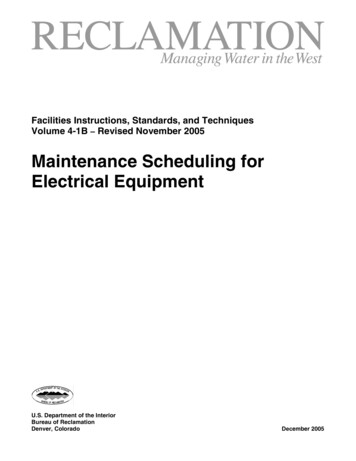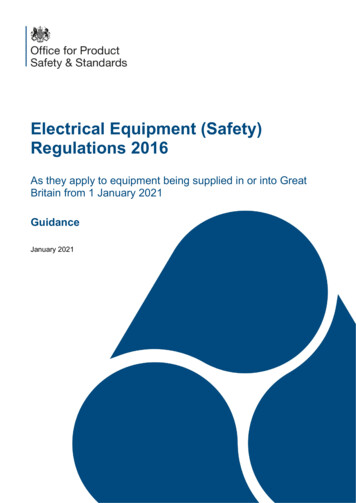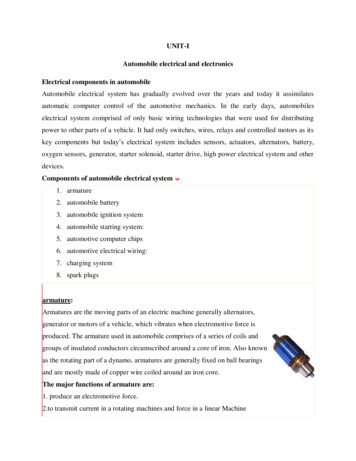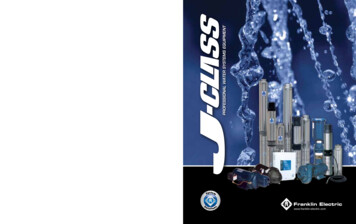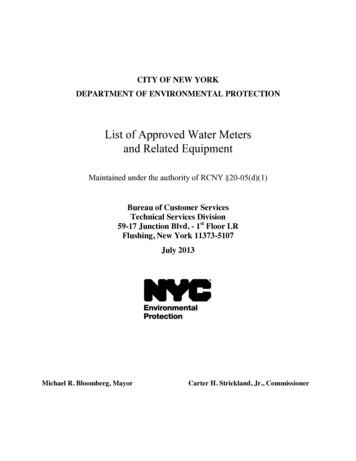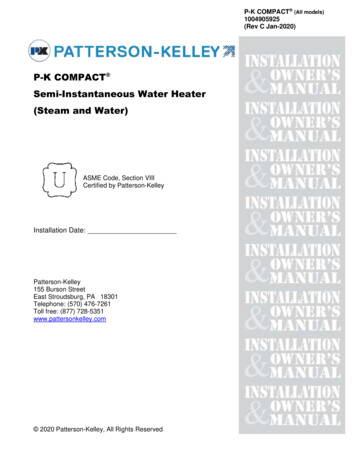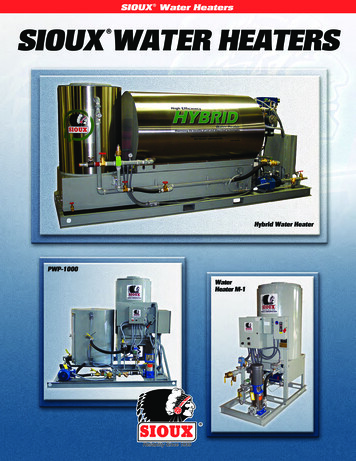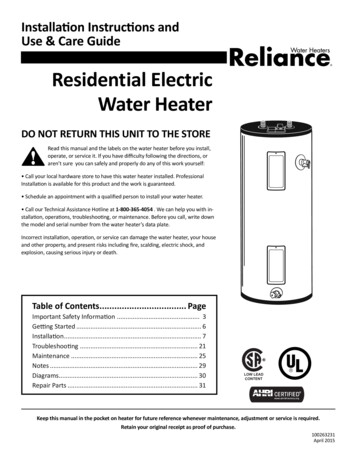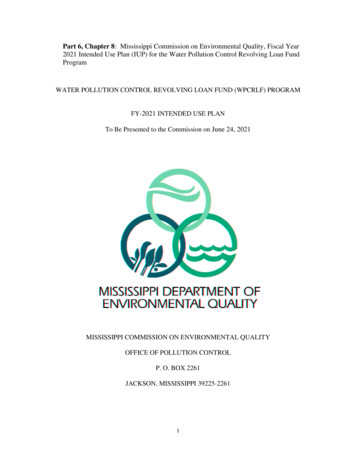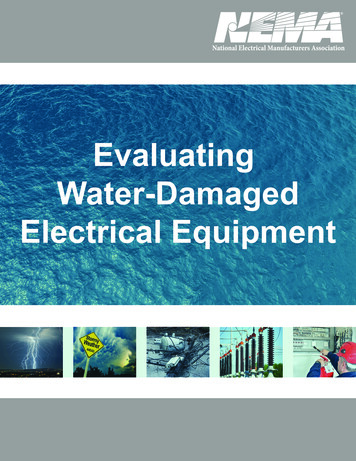
Transcription
EvaluatingWater-DamagedElectrical Equipment
1USE OF THIS PUBLICATIONThis publication serves as a guide that represents the consensus of NEMA member companies and isnot intended to override the recommendations of the specific equipment manufacturer. Theseguidelines provide information on how to evaluate electrical equipment that has been exposed to waterthrough flooding, fire-fighting activities, hurricanes, and other events involving large quantities of water.It is designed for use by suppliers, installers, inspectors, and users of electrical products. Whereadditional information is required, it is recommended that the specific electrical equipmentmanufacturers be consulted. Evaluation of electrical equipment should be conducted by qualifiedpersonnel.Electrical equipment exposed to water can be extremely hazardous if reenergized without performing aproper evaluation and taking necessary actions. Reductions in the integrity of electrical equipment dueto moisture can affect the ability of the equipment to perform its intended function. Damage to electricalequipment can also result from flood waters contaminated with chemicals, sewage, oil, and otherdebris, which will affect the integrity and performance of the equipment. Ocean water and salt spray canbe particularly damaging due to the corrosive and conductive nature of the saltwater residue.Distributors of electrical equipment should not supply any inventory that has been subjected to waterdamage. This can lead to the continued use of damaged equipment, creating a hazard to individuals orproperty.1.2 METHODS FOR EVALUATING WATER-DAMAGED ELECTRICAL EQUIPMENTThere are many methods for evaluating electrical equipment that has been exposed to water. This mayinclude visual observations, operational tests, or performance tests. Equipment discoloration, rust oroxidation, water marks, deposits (debris, chemicals, minerals), and material fatigue are all examples ofvisual observations. Operational tests compare the manual functions of the equipment exposed towater to new, properly operating equipment. Operational tests may determine abnormal switch ordisconnect operation by sound and feel, abnormal friction or resistance of rotating parts or motors,abnormally tight or loose contact devices such as receptacles, knife blades, bus clips, racking systems,etc. Like operational tests, performance tests compare known data points of equipment that may havebeen damaged by water to new, properly performing equipment. Insulation resistance testing, dielectricabsorption testing, and infrared thermographic imaging are a few examples of performance tests. Theoriginal manufacturer of the equipment should be contacted before performing any operational orperformance testing to prevent further damage to the equipment.2CONTACT THE MANUFACTURERWorking knowledge of electrical systems and the equipment in question is required to evaluate damagedue to contact with water. The original manufacturer of the equipment should be contacted if anyquestions arise or specific recommendations are needed. In many cases, a replacement will benecessary.After consultation with the manufacturer, some larger types of electrical equipment may bereconditioned by properly trained personnel. The potential to recondition the equipment may vary withthe nature of the electrical function, the degree of flooding, the age of the equipment, and the length oftime the equipment was exposed to water.Attempts to recondition equipment without consulting the manufacturer can result in additional hazardsdue to the use of improper cleaning agents, which can further damage the equipment (see NationalElectrical Code [NEC ] 110.11, Informational Note No. 2) or due to improper reconditioningtechniques. 2019 National Electrical Manufacturers AssociationPage 1
NEMA member companies are committed to safety. For specific contacts within these manufacturingfirms, call or write:National Electrical Manufacturers Association1300 North 17th Street, Suite 900Rosslyn, Virginia 22209Telephone: (703) 841-3236Fax: (703) 841-3336ATTN: Megan Hayesemail: megan.hayes@nema.org2.1 CONSULT THE AUTHORITY HAVING JURISDICTIONWhen considering the replacement or reconditioning of water-damaged electrical equipment, theauthority having jurisdiction should be consulted to obtain additional rules and other guidanceinformation impacting the installation. This may include licensing, permitting, and inspectionrequirements or other rules outlined in the locally adopted codes and standards. Where public safety isprimary, the authority having jurisdiction may be a federal, state, local, or other regional department orindividual such as a fire chief; fire marshal; chief of a fire prevention bureau, labor department, or healthdepartment; building official; electrical inspector; or others having statutory authority. For insurancepurposes, an insurance inspection department, rating bureau, or other insurance companyrepresentative may be the authority having jurisdiction. In many circumstances, the property owner orhis or her designated agent assumes the role of the authority having jurisdiction; at governmentinstallations, the commanding officer or departmental official may be the authority having jurisdiction.During declared federal or state emergencies, the Federal Emergency Management Agency (FEMA)may assume the role of authority having jurisdiction.3ELECTRICAL EQUIPMENT REPLACEMENT/RECONDITIONING REQUIREMENTSThe table below provides the requirements and recommendations associated with various categories ofelectrical equipment that have been subjected to water damage. Where it is shown that the equipment“may be reconditioned,” it is critical that the manufacturer of the equipment be contacted for specificguidance. Users are encouraged to reference the NEMA Policy on Reconditioned Electrical Equipment.Reconditioned equipment shall also comply with the marking requirements identified in the NationalElectrical Code . 2019 National Electrical Manufacturers AssociationPage 2
ReplaceequipmentEquipmentMay bereconditioned(contact themanufacturer)Additional standards reference(if available)ELECTRICAL DISTRIBUTION EQUIPMENT (refer to 4.1)Molded-case circuit breakersLow-voltage fusesXXSwitchesXBusway(Mylar wrapped bars)Busway(powder-coated bars)XXPanelboardsXSwitchboardsXNEMA KS 3-2010 Guidelines forInspection and Preventive Maintenance ofSwitches Used in Commercial andIndustrial ApplicationsNEMA BU 1.1-2000 General Instructionsfor Handling, Installation, Operation, andMaintenance of Busway Rated 600 Voltsor Less, par. 3.4.4, 9.2.4.2NEMA PB 1.1-2013 General Instructionsfor Proper Installation, Operation, andMaintenance of Panelboards Rated 600Volts or Less, par. 10.3, 10.8, 10.8.3,10.8.4, 10.9NEMA PB 2.1-2013 General Instructionsfor Proper Handling, Installation,Operation and Maintenance of DeadfrontDistribution Switchboards Rated 600 Voltsor Less, par. 9.1, 9.8, 9.8.3, 9.8.4, 9.9MOTOR CONTROL EQUIPMENT (refer to 4.2)Adjustable speed drivesComponents containingsemiconductors andtransistorsElectronically controlled andsolid-state contactors andstartersOverload relaysManual and magneticcontrollersMotor control centers (see4.2.2)XXXXXX 2019 National Electrical Manufacturers AssociationPage 3
EquipmentReplaceequipmentMay bereconditioned(contact themanufacturer)Additional standards reference(if available)POWER EQUIPMENT (refer to 4.3)Electrical connectorsElectronic trip units of LVpower circuit breakersHigh-voltage circuit breakers(AC)(As used in medium-voltageswitchgear)Low-voltage power circuitbreakers(AC)Electromechanical protectiverelays, meters, and currentsensors (see section 4.11for devices that containelectronic components)Electronic protective relays,meters, and currenttransformers (see section4.11)Low-voltage switchgearMedium-voltage switchgearMedium-voltage fusesXXXXXXXXXTRANSFORMERS (refer to 4.4)All dry-type transformersregardless of kVA ratingsAll dry-type control powertransformersLiquid-filled transformersCast-resin transformersXXX(Analysis of theinsulating mediumis required forevaluation of thisequipment.)XCONDUIT, TUBING, FITTINGS, OUTLET BOXES, AND JUNCTION BOXES (refer to 4.5)FittingsXOutlet and junction boxesXConduit and tubingX 2019 National Electrical Manufacturers AssociationNEMA FB 1-2007(R2010) Fittings, CastMetal Boxes and Conduit Bodies forConduit, Electrical Metallic Tubing (EMT)and CableNEMA OS 1-2008 (R2010) Sheet-SteelOutlet Boxes, Device Boxes, Covers andBox SupportsNEMA OS 2-2008 Nonmetallic OutletBoxes, Device Boxes, Covers and BoxSupportsPage 4
ReplaceEquipmentEquipmentMay beReconditioned(Contact themanufacturer.)Additional Standards Reference(if available)WIRE, CABLE, AND FLEXIBLE CORDS (refer to 4.6)Wire or cable listed for drylocations (such as NM-B)Wire or cable that is suitablefor wet locationsX(Provided the ends of thewire or cable have not beenexposed to water, and thewire is not damaged.)XAFCIs, GFCIs, SURGE PROTECTIVE DEVICES AND WIRING DEVICES (refer to 4.7)Arc-fault circuit interrupters(AFCI) and ground-faultcircuit interrupters (GFCI)Surge-protective devices(transient voltage surgesuppressors, surgearresters, lightning arresters)Wiring devices (switches,receptacles, dimmers, etc.)XXXOTHER DEVICESBatteries (refer to 4.12)Cable tray (refer to 4.8)XX(Replace damagedlabels.)Fire pump controllersXLighting equipment(refer to 4.9)Motors (refer to 4.10)Power resistors and relatedassembliesSignaling, protection, andcommunicationssystems(refer to 4.11)Uninterruptible power supply(UPS)NEMA ICS 15-2011 Instructions for theHandling, Installation, Operation, andMaintenance of Electric Fire PumpControllers Rated Not More Than 600VXXANSI/IEEE 43-2013, A2 and A3,ANSI/EASA AR100XXX 2019 National Electrical Manufacturers AssociationPage 5
4THE HAZARDS ASSOCIATED WITH WATER-DAMAGED ELECTRICAL EQUIPMENT4.1Electrical Distribution EquipmentElectrical distribution equipment usually involves switches and low-voltage protective components suchas molded-case circuit breakers and fuses within assemblies such as enclosures, panelboards, andswitchboards. These assemblies can be connected to electrical distribution systems using variouswiring methods.The protective components are critical to the safe operation of distribution circuits. Their ability toprotect these circuits is adversely affected by exposure to water and to the minerals, contaminants, andparticles, which may be present in the water. In molded-case circuit breakers and switches, suchexposure can affect the overall operation of the mechanism through corrosion, through the presence offoreign particles, and through loss of lubrication. The condition of the contacts can be affected, and thedielectric insulation capabilities of internal materials can be reduced. Further, some molded-case circuitbreakers are equipped with electronic trip units, and the functioning of these trip units can be impaired.Water may affect the filler material of fuses and will degrade the insulation and interruption capabilities.Distribution assemblies contain protective components together with the necessary support structures,buswork, wiring, electromechanical, or electronic relays, and meters. Exposure to water can causecorrosion and insulation damage to all of these areas. In the case of exposure of distributionassemblies to water, contact the manufacturer before further action is taken.4.2Motor Control EquipmentMotor circuits include motor control devices such as motor starters and contactors, which—togetherwith overcurrent protection components such as overload relays, circuit breakers, and fuses—are oftenassembled into motor control panels and motor control centers, as well as individual enclosures. Motorcontrol centers contain both control and protective components, together with support structures,buswork, and wiring.The protective components are critical to the safe operation of motor circuits, and their ability to protectthese circuits is adversely affected by exposure to water and to the minerals, contaminants, andparticles that may be present in the water. For molded-case circuit breakers, such exposure can affectthe overall operation of the mechanism through corrosion, through the presence of foreign particles,and through loss of lubrication. The condition of the contacts can be affected, and the dielectricinsulation capabilities of internal materials can be reduced. Further, some molded-case circuit breakersare equipped with electronic trip units, and the functioning of these trip units can be impaired. Watermay affect the filler material of fuses and can degrade the insulation and interruption capabilities.Corrosion, loss of lubrication, and insulation quality can also be expected in contactors and starters.Solid-state motor controllers, adjustable speed drives and those electromechanical contactors orstarters with integral electronic circuitry will be more severely affected by water.4.2.1Adjustable Speed DrivesAdjustable speed drives generally contain electronic components. See section 4.11 for information onequipment with electronic components. For other components of an adjustable speed drive, the abilityto refurbish those components will depend on the type of component involved and the extent of thedamage. The manufacturer of the drive must be consulted before any attempt to refurbish theequipment.4.2.2Motor Control CentersMotor control centers contain many different components, including fuses, circuit breakers, controllers,overload relays, and adjustable speed drives, as well as components such as buswork, insulators, and 2019 National Electrical Manufacturers AssociationPage 6
enclosures. Many of these components are covered in other parts of this document and should bereferenced for additional information on those components.For the buswork and structural assembly, exposure to water can cause corrosion and insulationdamage. For these assemblies, contact the manufacturer before further act
NEMA PB 2.1-2013 . General Instructions for Proper Handling, Installation, Operation and Maintenance of Deadfront Distribution Switchboards Rated 600 Volts or Less , par. 9.1, 9.8, 9.8.3, 9.8.4, 9.9 . MOTOR CONTROL EQUIPMENT (refer to 4.2) Adjustable speed drives X Components containing semiconductors and transistors X . Electronically controlled and solid-state contactors and starters X .


